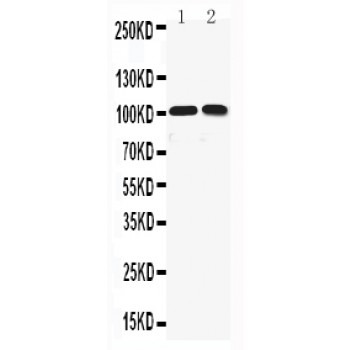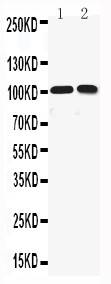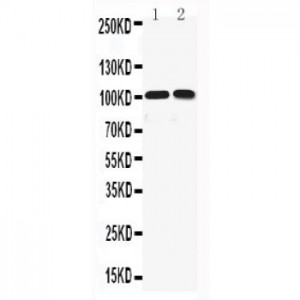More info
Overview
Long Name | Antibody Type | Antibody Isotype | Host | Species Reactivity | Validated Applications | Purification |
| potassium voltage-gated channel, KQT-like subfamily, member 5 | Polyclonal | IgG | Rabbit | Human, Mouse, Rat | WB | Immunogen affinity purified. |
Immunogen | ||||||
| A synthetic peptide corresponding to a sequence at the C-terminus of human KCNQ5(619-633aa KLDCLLDIYQQVLRK), identical to the related mouse and rat sequences. | ||||||
Properties
Form | Lyophilized |
Size | 100 µg/vial |
Contents | Antibody is lyophilized with 5 mg BSA, 0.9 mg NaCl, 0.2 mg Na2HPO4, 0.05 mg Thimerosal and 0.05 mg NaN3. *carrier free antibody available upon request. |
Concentration | Reconstitute with 0.2 mL sterile dH2O (500 µg/ml final concentration). |
Storage | At -20 °C for 12 months, as supplied. Store reconstituted antibody at 2-8 °C for one month. For long-term storage, aliquot and store at -20 °C. Avoid repeated freezing and thawing. |
Additional Information Regarding the Antigen
Gene | KCNQ5 |
Protein | Potassium voltage-gated channel subfamily KQT member 5 |
Uniprot ID | Q9NR82 |
Function | Probably important in the regulation of neuronal excitability. Associates with KCNQ3 to form a potassium channel which contributes to M-type current, a slowly activating and deactivating potassium conductance which plays a critical role in determining the subthreshold electrical excitability of neurons. May contribute, with other potassium channels, to the molecular diversity of a heterogeneous population of M-channels, varying in kinetic and pharmacological properties, which underlie this physiologically important current. Insensitive to tetraethylammonium, but inhibited by barium, linopirdine and XE991. Activated by niflumic acid and the anticonvulsant retigabine. Muscarine suppresses KCNQ5 current in Xenopus oocytes in which cloned KCNQ5 channels were coexpressed with M(1) muscarinic receptors. |
Tissue Specificity | Strongly expressed in brain and skeletal muscle. In brain, expressed in cerebral cortex, occipital pole, frontal lobe and temporal lobe. Lower levels in hippocampus and putamen. Low to undetectable levels in medulla, cerebellum and thalamus. |
Sub-cellular localization | Membrane; Multi-pass membrane protein. |
Sequence Similarities | Belongs to the potassium channel family. KQT (TC 1.A.1.15) subfamily. Kv7.5/KCNQ5 sub-subfamily. |
Aliases | KCNQ 5 antibody|KCNQ5 antibody|KCNQ5_HUMAN antibody|KQT like 5 antibody|KQT-like 5 antibody|Kv7.5 antibody|OTTHUMP00000064152 antibody|OTTHUMP00000064153 antibody|Potassium channel alpha subunit KvLQT5 antibody|Potassium channel protein antibody|Potassium channel subunit alpha KvLQT5 antibody|Potassium voltage gated channel KQT like subfamily member 5 antibody|Potassium voltage gated channel subfamily KQT member 5 antibody|Potassium voltage-gated channel subfamily KQT member 5 antibody|Voltage gated potassium channel subunit Kv7.5 antibody|Voltage-gated potassium channel subunit Kv7.5 antibody |
Application Details
| Application | Concentration* | Species | Validated Using** |
| Western blot | 0.1-0.5μg/ml | Human, Mouse, Rat | AssaySolutio's ECL kit |
AssaySolution recommends Rabbit Chemiluminescent WB Detection Kit (AKIT001B) for Western blot. *Blocking peptide can be purchased at $65. Contact us for more information

Anti-KCNQ5 antibody, ASA-B1113, All Western blotting
All lanes: Anti-KCNQ5(ASA-B1113) at 0.5ug/ml
Lane 1: Rat Brain Tissue Lysate at 40ug
Lane 2: Mouse Brain Tissue Lysate at 40ug
Predicted bind size: 102KD
Observed bind size: 102KD
All lanes: Anti-KCNQ5(ASA-B1113) at 0.5ug/ml
Lane 1: Rat Brain Tissue Lysate at 40ug
Lane 2: Mouse Brain Tissue Lysate at 40ug
Predicted bind size: 102KD
Observed bind size: 102KD



